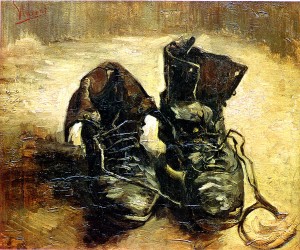It’s gotta be the shoes
Below are several quotes about how art can embody an immediate intuition of the whole of life, and they deserve more attention than appearing in a list here, which is all I can manage at the moment. All three of these writers suggest that visual art can convey far more than it ostensibly is showing you, on its surface. Not metaphorically, but through a purely sensory impression. These three suggest that sensory experience can convey something more encompassing than conceptual knowledge, more subliminal, and more inclusive and unifed—the awareness of the world’s wholeness. Becket tries to explain how this works, in purely psychological terms, and in extremely recondite language, in his essay on Proust. All of these writers suggest something that seems to me alien to much of what’s been implicit in the tradition of Western painting, if not in the practice of it, certainly in the intellectual theorizing that usually runs parallel alongside it. It’s actually closer to traditions of Chinese and Japanese painting.
Harper’s did a funny commentary on the Heidegger quote and how it gave rise to even less comprehensible passages from postmodern theorists, who adopted the German thinker’s practice of inventing their own difficult language to convey their ideas. For example, I’m not sure why he needed “attain to unconcealedness” when “reveal” would seem to do just as well. It would have been so much clearer if he’d simply said: “Looking at the pair of shoes Van Gogh painted, you don’t simply see the objects, but you see the months and years of labor in the fields, the weather of different seasons, the passage of time . . . the entirety of the life built around the protection they offered to a worker’s feet.” In other words, the shoes in Van Gogh’s painting do what landscape paintings more often do: awaken the sense of an entire life, the passing seasons, the passage of time. Something along those lines might have won Heidegger more readers, but mostly he preferred to stick to his oracular pose. These quotes also tangentially remind me of T.S. Eliot’s famous remark about Henry James: “He had a mind so fine no idea could violate it.” It’s always struck me as a quote just as applicable to many of the greatest painters.
Truth happens in Van Gogh’s painting. . . This does not mean that something is correctly represented and rendered here, . . . (it) does not mean that something which is at hand is correctly portrayed, but rather that in the revelation. . . . of the shoes . . . world and earth in their counterplay attain to unconcealedness . . . this shining, joined in the work, is the beautiful. Beauty is one way in which truth essentially occurs in unconcealedness.
—Heidegger, The Origin of the Work of Art
And as soon as I had recognized the taste of the piece of madeleine soaked in her decoction of lime-blossom which my aunt used to give me . . . in that moment all the flowers of our garden and in M. Swann’s park, and the water-lilies on the Vivonne and the good folk of the village and their little dwellings and the parish church and the whole of Combray and its surroundings, taking shape and solidarity, sprang into being, town and garden alike, from my cup of tea.
—Proust
The most successful evocative experiment can only project the echo of a past sensation, because, being an act of intellection, it is conditioned by the prejudices of the intelligence which abstracts from any given sensation, . . . whatever word or gesture, sound of perfume, cannot be fitted into the puzzle of a concept. But the essence of any new experience is contained precisely in this mysterious element that a vigilant will rejects as an anachronism . . . no amount of voluntary manipulation can reconstitute in its integrity an impression that the will has—so to speak—buckled into incoherence. But if, by accident, . . . . the central impression of a past sensation recurs as an immediate stimulus which can be instinctively identified by the subject . . .then the total past sensation, not its echo or copy, but the sensation itself, . . . . comes in a rush to engulf the subject in all of the beauty of its infallible proportion.
The most trivial experience . . . is encrusted with elements that logically are not related to it and have consequently been rejected by our intelligence . . . (therefore) Proust does not deal in concepts, he pursues . . . the concrete. He admires the frescoes of the Paduan Arena because their symbolism is handled as a reality, special, literal and concrete, and is not merely the pictorial transmission of a notion.
Lying in bed at dawn, the exact quality of the weather, temperature and visibility, is transmitted to him in terms of sound, in the chimes and the calls of the hawkers.
—Samuel Beckett

“I’m not sure why he needed ‘attain to unconcealedness’ when ‘reveal’ would seem to do just as well.”
Heidegger is transliterating the Greek word for truth a-letheia, which literally is un-hidden. Reveal is a Latin derived word, which the Greeks didn’t use. It makes more sense when read in the context of the rest of the essay.
I think Heidegger, in his work, was generally struggling to use the existing language to get at what traditional philosophical “thinking” itself can’t approach very effectively and which maybe doesn’t really fit into the subject-verb-object structure of language itself, hence the way he seems to invent his own vocabulary. If I understand him correctly, I agree with what he’s expressing in this passage, but wonder if he couldn’t have tried for an approach, maybe in another essay, that would have been more inclusive for his readers/listeners. “Unhidden”, or some “unhidden-ness”, sounds less magisterial and more approachable than the English translation “attain to unconcealedness.” Thanks for clarifying this.